It took 20 years and £6 billion to build the Large Hadron Collider, the world’s biggest particle accelerator.
Now, scientists want to make another one that’s even larger – and twice as expensive.
The £13 billion ‘Future Circular Collider’ (FCC) will loop a whopping 56.5-miles (91km) deep underground at the Swiss-French border.
FCC will be nearly four times more powerful than the Large Hadron Collider (LHC), which has been in operation since 2010.
Dubbed the ‘world’s biggest atom smasher’, FCC could provide new physics discoveries that explain the structure and evolution of the universe.
CERN (The European Organization for Nuclear Research) Director-General Fabiola Gianotti said it could become ‘the most extraordinary instrument ever built by humanity to study the constituents and the laws of nature at the most fundamental levels’.
However, not everyone is on board with the project – with sceptics urging CERN to abandon it on the basis that it could emit millions of tons of dangerous climate-warming CO2.
What’s more, critics have raised concerns that the FCC would begin operations in the mid-2040s but run for only about two decades or less.
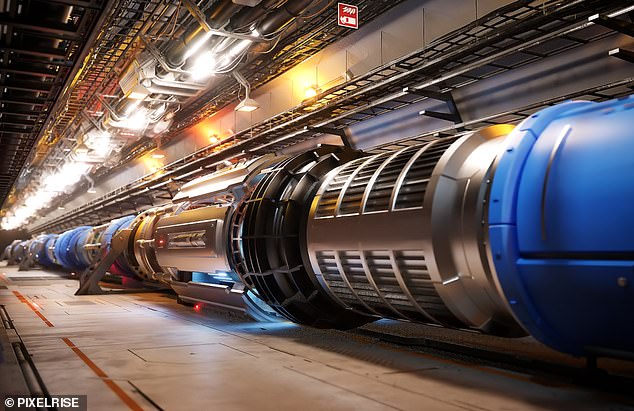
Artistic depiction of the tunnel for the FCC, which would be arranged in a ring across the French-Swiss border
CERN has released detailed plans for the FCC – a concept mooted over a decade ago.
The organisation estimates that it will cost £13.4 billion ($17.4 billion) to dig a 56.5-mile (91km) circumference tunnel and build the machine.
The proposed Future Circular Collider would be active for 15 to 20 years from around 2040, around the time the LHC comes offline.
Just like the LHC, the FCC would accelerate subatomic particles to almost the speed of light in its underground ring, before smashing the particles into each other.
Physicists use superconducting magnets to beam the particles at these high speeds and then use detectors to capture the collisions.
These collisions produce a burst of new particles, which physicists record and study in order to better understand the basic building blocks of nature.
Not only will the upcoming machine be nearly four times as large, but it will be equipped with double-strength magnets for more power.
It could ultimately help to solve many of the universe’s unanswered mysteries, including dark matter and dark energy, both invisible to us.
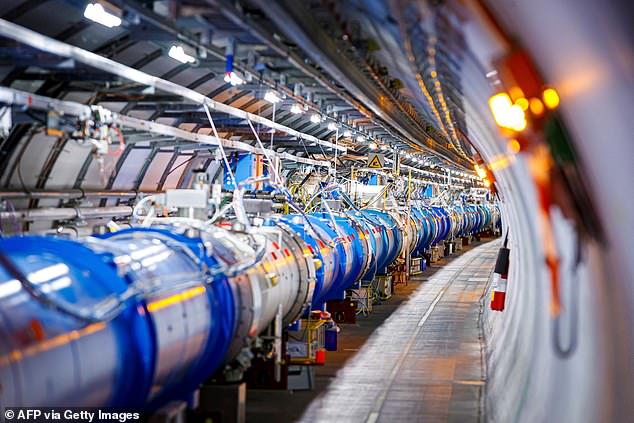
The projected cost of about $17 billion is more than twice the $8 billion price tag of the Large Hadron Collider (LHC, pictured)
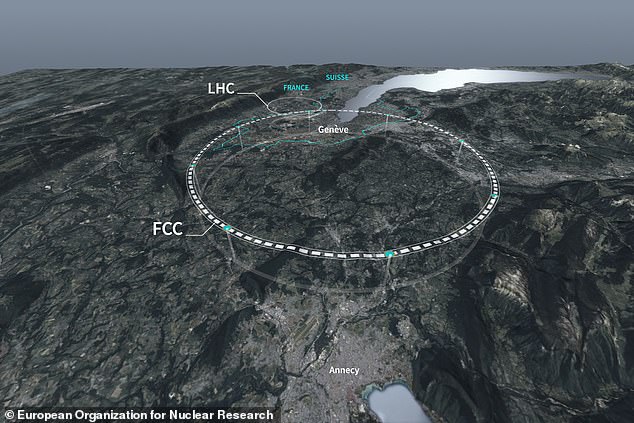
CERN Director-General Fabiola Gianotti said the future collider could become ‘the most extraordinary instrument ever built by humanity to study the constituents and the laws of nature at the most fundamental levels’
CERN said it is not possible to say exactly what benefits the new collider would bring to the world, but pointed out that the discovery of the electron in 1897 led to the electronics industry.
In 2012, the LHC made headlines when it proved the existence of the Higgs boson, the elusive particle dubbed the God particle, which helped explain how matter formed after the Big Bang.
Higgs boson is a key element of the Standard Model of particle physics, which is our best understanding of how the universe works.
However, there are questions over how the project will be funded – and it remains unclear if CERN’s member states will pay for it.
CERN’s member states – 23 European countries including the UK plus Israel – need to decide by 2028 whether to release the funds needed.
CERN spokesman Arnaud Marsollier tried to allay those concerns, insisting that up to 80 per cent of the FCC’s cost could be covered by the organization’s budget.
But scientists, eco-friendly groups and local farmers are not convinced it is even necessary or safe for the environment.
In a report, environmental association Noe21 criticised the ‘excessive’ project, pointing to its ‘astronomical electricity consumption’, cost and impact on the climate.
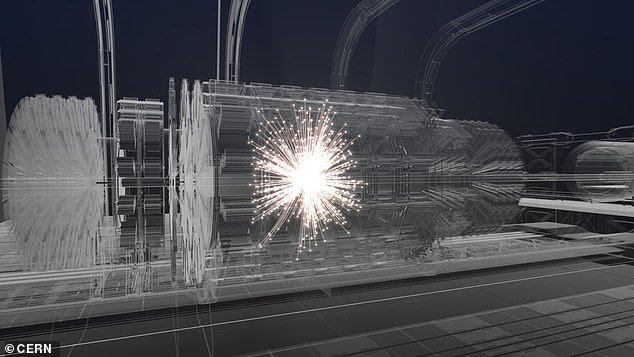
Particle colliders accelerate subatomic particles to almost the speed of light around giant underground rings, before smashing them into each other. To do so, they use superconducting magnets to beam the particles at incredible speeds around giant underground rings, using detectors to capture the collisions
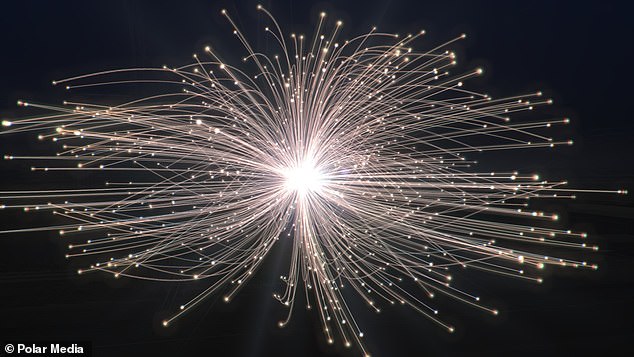
Artistic view of a collision event at the FCC. Expanding our understanding of the fundamental laws of nature requires the energy frontier to be pushed much further, CERN researchers said of the upcoming collider
It would require the excavation of 16 million tons of rock and could emit millions of tons of CO2 – a concern especially considering the scientific benefits are uncertain.
Thierry Perrillat, a dairy farmer in Roche-sure-Foron in France, said the planned collider would swallow ‘five hectares of our farm’, describing it as ‘like David and Goliath’.
Sabine Hossenfelder, a theoretical physicist at the Frankfurt Institute for Advanced Studies, said the money needed to build the FCC could be better used elsewhere.
It could be better spent on a radio telescope on the moon, a gravitational wave detector in space, or more direct research funding.
‘There is no reason to think that there should be new physics in the energy regime that such a collider would reach,’ Hossenfelder told Nature.
‘That’s the nightmare that everyone has on their mind but doesn’t want to speak about.’
Physicist Olivier Cepas at the Neel Institute at the University of Grenoble called the ‘financial, ecological and operating costs ‘astronomical’.
‘It would be better to fund smaller scientific projects,’ he told AFP.
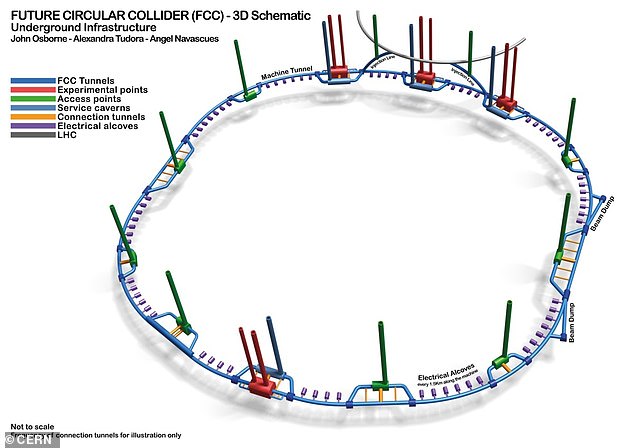
An illustration of the layout of the FCC including locations of tunnels and experiments
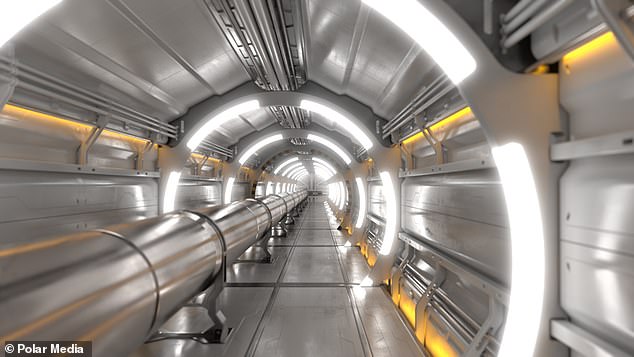
Artistic impression of the FCC accelerator and tunnel. Not only will the machine be larger, but it will be equipped with double strength magnets for more powerful collisions
Sir David King, a former chief scientific adviser to the UK government, said he is ‘not in favour’ of FCC and admitted the particle physics community is split.
‘We can keep building higher and higher energy systems, and we will find new particles,’ he told the Times.
‘But this science wouldn’t be relevant to the most pressing challenges we face on Earth.’
FCC has already had unanimous approval by the CERN council, but now CERN has released feasibility studies regarding the physics, technical infrastructure, safety and more.
However, approval from CERN doesn’t mean it will definitely be going ahead as it will still need to secure funding from CERN’s member countries.










